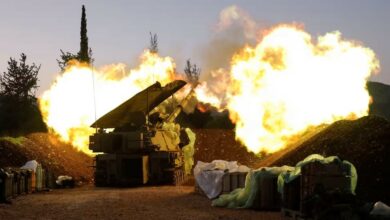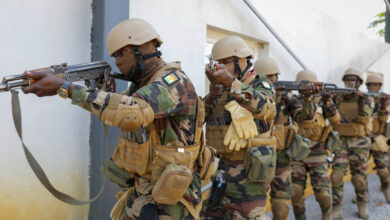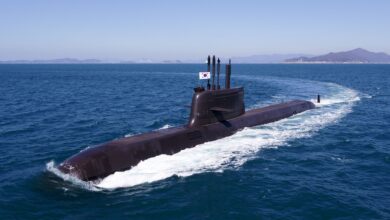The United Nations is in talks with Canada for early deployment of six helicopters to its Minusma peacekeeping force in Mali, but its representative said that six helicopters is not enough and pointed to other equipment shortfalls.
The U.N.’s Mahamat Saleh Annadif said on Wednesday, April 11 that Canada will send the helicopters in August but that the mission needs them in June, when Germany pulls out of the mission with its fleet.
After two years of talks with the U.N., Canada announced in March that it will send two Chinook transport helicopters and four Griffon attack helicopters to the MINUSMA mission in Mali.
Annadif, who is the Special Representative of the Secretary-General and head of the Minusma mission, said talks were ongoing with Canada and Germany to avoid a vacuum.
“We want them in June,” he told a news conference at U.N. headquarters in New York after briefing the U.N. Security Council on Mali.
He told the Security Council that Minusma was conducting more and bigger patrols, particularly in the center of Mali, to reassure the population, assess the human rights situation and engage with communities in hard‑to‑reach areas.
Emphasizing the need to prioritize the training of peacekeeping troops, he said Minusma is about 100 armored vehicles short of fulfilling its needs, and that contributing countries had been asked to try to fill the equipment gap.
Canada’s offer of six helicopters fell short of what was needed, he said.
A spokesperson for Canada’s defense ministry told The Defense Post that planning has begun but that the details have not yet been worked out.
“Since the planning process has only just begun for Canada’s contribution to MINUSMA, details remain to be determined. For that reason, it’s too early to provide you with any specific answers,” the spokesperson for the Department of National Defence said.
Update April 12 Giving further details, another Canadian spokesperson appeared to pour cold water on plans for early deployment.
“Details regarding the final structure and chain of command of the Canadian mission in Mali are still to be determined,” Byrne Furlong, spokesperson for Canada’s defense minister, told AFP.
These issues along with the military equipment to be deployed and other mission details “will be addressed during upcoming reconnaissance and negotiations with the United Nations,” she said. “It is important to keep in mind that preparing for a mission can take several months.”
The number of troops and the specific skill sets required “will be determined as a result of the planning process and engagement with the U.N., partners and the host nation,” Furlong added.

Multiple missions in Mali
France launched an intervention to chase out jihadists linked to al-Qaeda who had overtaken key northern cities in Mali in 2013. That mission evolved into the current Operation Barkhane deployment launched in 2014 with an expanded mandate for counter-terror operations across the Sahel region of west Africa, and around 4,000 French troops are deployed.
The U.N.’s MINUSMA peacekeeping force has around 12,000 military and 1,900 police personnel deployed from 57 U.N. partner nations, and is considered the U.N.’s most dangerous. Seven U.N. peacekeepers have been killed in attacks in Mali this year alone. In the past week, one U.N. peacekeeper from Niger was shot dead in northern Mali and in a separate attack, two U.N. peacekeepers were killed and 10 wounded by mortars in the country’s northeast.
Meanwhile, Burkina Faso, Chad, Mali, Mauritania and Niger set up the 5,000-strong G5 Sahel joint counter-terrorism force that aims to train 5,000 troops to work alongside the French troops and the U.N.
The G5 Sahel Joint Force initiative was spearheaded by France, leading to a U.N. Security Council resolution in June 2017 that called for international logistical, operational and financial support to G5 Sahel initiative. The group is currently supported by France, the U.S., and the E.U. among others.
But the first operation of the G5 force in November was beset by logistical problems, although a commander insisted that they “have lots of lessons to learn, but I don’t think it is insurmountable.”
The U.N. Security Council in December authorized Minusma to provide assistance to the G5 Sahel, saying that the mission contributes to a more secure region and thus facilitates the Minusma mandate to stabilize Mali. The authorization is solely for operations in Malian territory, and can include medical and casualty evacuations, the provision of fuel, water and food, as well as U.N. engineering plant equipment and material and uniformed Minusma engineering units to assist in preparation of bases.
The support is to be given only when it does not impact Minusma’s own operations.
Annadif told the meeting of the Security Council that, further to the agreement reached in Brussels in February between the U.N., the European Union and the G5 Sahel, Minusma had sketched out a framework for its support of the G5 Sahel force, and that mechanisms for medical evacuations and logistical support were now operational.
The Canadian helicopters will be configured for exactly this kind of transport role, but the Canadian government did not mention support for the G5 Sahel when it said last month it would send helicopters to Mali.
“Details remain to be determined as negotiations with the United Nations have yet to begin,” Defence Department spokesperson jessica Lamirande told The Star. “Specifics regarding the exact [Canadian Armed Forces] contribution, and how that CAF contribution will be used, are some of the many factors that will be addressed during upcoming reconnaissance and negotiations with the United Nations.”
However, asked on Monday if Canadian forces would help the G5 Sahel, Defence Minister Harjit Sajjan said Canada has “actually been supporting the G5 Sahel force for some time,” The Star reported.
“We’ve been doing capacity-building in that region,” he said, adding that Canada has “been supporting with logistical support to the French with tactical airlift.”
A Department of National Defence spokesperson clarified these remarks.
“When the Minister spoke on Monday, he was referencing the support that’s already being provided in the Sahel region, not new support in Mali,” the spokesperson told The Defense Post.
The spokesperson said that Canada was at the time supporting Operation Barkhane through its Operation Frequence, and has still has personnel deployed on Operation Naberius, a military training and capacity building mission in Niger.
“We have been providing airlift support to the French for their [Operation Barkhane], which happens to cover the same 5 nations as the G5 Sahel, but is a bilateral agreement with France, and not the G5 Sahel. That support began in 2014, was renewed last year, and recently ended on March, 31, 2018.”
“It is important to note that this previous support in the region is not connected to Canada`s upcoming support of MINUSMA, the details of which are still to be determined,” the spokesperson said.
Canada’s support to the other missions in the Sahel region are not unique, and in recent months, several other countries have pledged aid.
In February, the E.U. said it would double its financial contribution to the G5 Sahel joint force, and in March, Estonia said it would ask parliament for a mandate to send 50 troops to Mali for one year.
At the Security Council briefing, U.K. representative Karen Pierce said that Minusma must be properly equipped to fulfil its mandate, and called on states to provide equipment, recalling that in January, the U.K. government said it would send three additional Chinook helicopters to Mali for French military use in Operation Pagnali, a mission apparently outside the Minusma mandate that involves the French and G5 forces.
Annadif’s call for more armored vehicles and early deployment of Canada’s helicopters even though they fall short of what is needed seems to point towards problems for the U.N. mission there, due to the competing needs of the multitude of missions in Mali.
The Defense Post contacted Minusma with a number of questions about its mission requiremenrts, but did not receive a response.
Anna Varfolomeeva contributed reporting, and this post also includes reporting from AFP.
This post was updated on April 12 with additional comment from Canada’s defense ministry.












